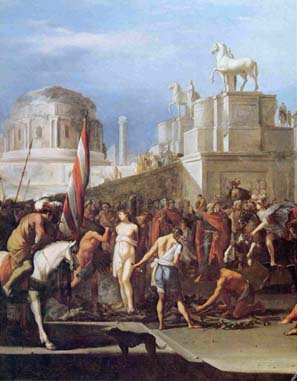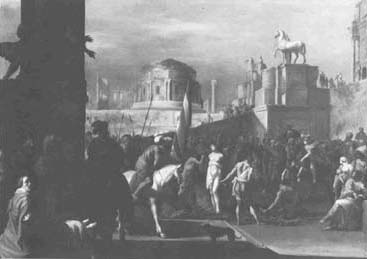
Bulletin 26, 1975
Home
Français
Introduction
History
Annual Index
Author &
Subject
Credits
Contact


A
Poelenburgh in the National Gallery of Canada
by Malcolm Waddingham
Résumé en français
Pages 1 | 2 |
3 | 4
Unfortunately, few of
the many Dutch and Flemish artists who visited Italy (even for
several years) during the first half of the seventeenth century left
behind many paintings from their stay unless, like Paul Brill, they
spent most of their adult life in that country. One important
exception was Cornelis van Poelenburgh (1586?-1667) (1) who lived in
Italy for just under a decade, from 1617 to some time before 1627
when he was recorded back home in Utrecht. (2) According to Sandrart,
Poelenburgh visited both Rome and Florence, and in Florence met
Callot. (3) (If that information can be relied on, this meeting must
have occurred before Callot returned to Nancy in 1621.) From other
sources, however, it is evident that Poelenburgh spent much more
of his time in Rome than in Florence.
Unlike many of his compatriots, who had also come to learn from the
revered Italian tradition, Poelenburgh was not reluctant to
attempt an ambitious religious theme or literary subject. To what
extent he was capable of producing such pieces has become clearer
now that his narrative works are distinguished from those of
Bartholomeus Breenbergh (1599?-1657), who was in Italy in 1619 and
in Rome for most of the 1620s. Several important pictures from
Poelenburgh's Italian period were incorrectly attributed to
Breenbergh during the nineteenth century, a mistake generally
accepted until Eckhard Schaar, in an excellent article published in
1959, (4) returned some of them to the proper artist. One false
attribution Schaar did not mention, however, concerns one of
Poelenburgh's most striking Italian-period creations, Clorinda
Saving Olindo and Sofronia from the Stake (fig. I), now in the
National Gallery of Canada, Ottawa.
I first saw this copper panel in 1952 when it was on loan from the
collection of Captain Eric Palmer and included as a Breenbergh in
that massive show Dutch Pictures 1450-1750 (cat. no. 22), at
the Royal Academy of Arts, London. (5) My notes from that time record
only its colouring and contain no reference to the attribution.
Several years later, in February 1958, I was invited to study
Palmer's collection of paintings at Wooburn Green, near
Beaconsfield, Buckinghamshire. On the back of the photograph which
he gave me of his so-called Breenbergh I noted, "figures by
Poelenburgh." When it was included in the 1965 exhibition in
Utrecht, Nederlandse 17e Eeuwse Italianiserende
Landschapschilders (cat. no. 31), it was encouraging to see
that although this picture was again shown as a Breenbergh (probably
out of respect to the owner), A. Blankert, the scholar responsible
for the catalogue entry, treated it as certainly by Poelenburgh.
And this it is: a chef-d'oeuvre from his Italian period, as will
be seen from comparisons with other early works.
Poelenburgh's choice of subject was taken from Torquato Tasso's Gerusalemme
Liberata, the epic poem of 1574 which covers the capture
of Jerusalem during the First Crusade. (6) King Aladine, the Mohammedan
ruler of Jerusalem, had stolen an image of the Virgin Mary from a
Christian church and placed it in the Royal Mosque. The statue was
again mysteriously stolen and, in anger and fury, Aladine decided to
massacre the Christians. In order to placate the king's rage and
save her friends, Sofronia, a young woman of great beauty, falsely
admitted to having stolen the statue. As a result she was condemned
to death by fire. Olindo, her lover, tried to save her by claiming,
also untruthfully, that it was he who had taken the image. Both were
tied to the stake and saved only by Clorinda who arrived mounted on
a proud and rearing horse, looking more like a heroic warrior than
a young Saracen woman.
Though ambitious, this panel nonetheless remains independent of this
style and iconography manifested in the twenty-one engravings
produced by Agostino Carracci and Giacomo Franco (after Bernardo
Castello's drawings) for a 1590 edition of the same poem. (7)
Poelenburgh does full justice to the drama of the story, underlines
the physical beauty of the half-naked Sofronia, (8) and carefully
records his affection for some of the recent innovations in
architecture as well as for monuments of Roman antiquity. Confidence
was needed for a northern artist in Italy not to produce a
religious piece too obviously derived from Renaissance tradition.
Quietly and independently Poelenburgh creates an individual,
imaginative location which is a revealing statement of his own
responses to Rome.
Placed in their new situation in 1583, the two antique Roman
Dioscuri on broad classical bases stand out against the sky. As in
real life, La Cordonata (the recently built, shallow ramp leading
from the Campidoglio) cuts down between them. Several richly garbed
riders descend from the top. Beyond this staircase a circular,
temple-like building commands the upper centre of the picture; its
roof lightly refers to that of the Pantheon, and its shape and
design allude in a more general and vague fashion to the dome of St
Peter's. Supporting this edifice is a powerful wall-like base
which has been interpreted as a "paraphrase of Maderno's facade
to St Peter's of 1607-14." (9) But no less important, in my view,
is to recognize how the central background buildings are delineated
with acute sensitivity to their delicacy of tone. With the exception
of the column on the right of the cupola, which intentionally looks
like a version of the Column of Marcus Aurelius or that of Trajan,
there are no literal transcriptions of particular buildings. The
references, like the one to the monument on the far right (which
resembles the Arch of Constantine) or the huge simple columns on
the left, are broad and are evocations of magnificence and power.
Poelenburgh was far from being the first Dutchman to depict a Roman
background; but new was the way he described (pursuing the late
manner of Brill) the ruins and architecture with fresh realism and a
marked feeling for their idyllic aspect. However, he did not want to
convey a contemporary scene too literally, for the story was set in
the Middle Ages. This in itself was not without challenge in
iconography. One problem concerned the style of dress for the characters
and their deportment and behaviour. (In Tasso these incidents
are merely used allusively in medieval style, and so in some ways it
constituted less of a problem to the writer than to the artist.)
Like most painters of his time, Poelenburgh was not interested in
portraying the visual character of a specific historical period.
For him the past connoted a classical or Renaissance style, so no
effort is made to convey a touch of Romanesque colour or atmosphere.
(Distinctions of period in costume were so much less important in
art during this time than in romantic and later times when painters
were keener to record historical fashions correctly.) Clorinda,
mounted on her rearing horse, springs out of the Renaissance, for
the animal is inspired by the horse in Raphael's Expulsion of
Heliodo in the Stanza d'Eliodoro. Similarly, the
general shape and structure of the back of the servant to the right
of Sofronia is influenced by the almost naked figure of the servant
who suspends the baby by its legs in Raphael's Judgement of
Solomon in the Stanza della Segnatura. Equally dependent on a
Renaissance world are many of the characters standing behind the
condemned couple. This is also true of the three slaves who prepare
the wood around them; they are statements of respect for the
physical and classical beauty of a male body, but a body revitalized
by the muscularity inspired by Michelangelo. Compared with
them, however, the rider in the lower-left corner is obviously an
early seventeenth-century man. No attempt is made to disguise his
assured elegance and virility - understandable when it is known that
this is a self-portrait of the artist. (10)
Next Page | Poelenburgh's
maturity
1 |
2 |
3 | 4
Annual Index | Author & Subject | Credits | Contact
This digital collection
was produced under contract to Canada's Digital Collections program,
Industry Canada.
"Digital
Collections Program, Copyright
© National Gallery of
Canada 2001"